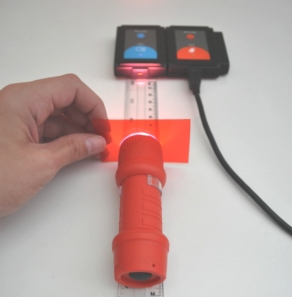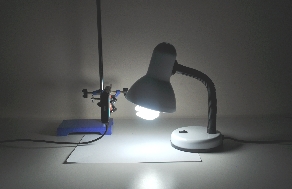Light sensor brought to light
05/26/2016
One of the first sensors I worked with was the light sensor. It is amazing how this sensor can be used in so many fields of science. I started by creating experiments that teach the most basic principles of light.
The Light and Dark Colors experiment demonstrates the principle of light reflection and absorption. When visible light (that contain all the colors), completely reflects from an object, this light appears white. When the object completely absorbs all the light, it is recognized as black. This was done by projecting light on white, grey and black papers and measuring the reflected light. One of the responses I received from teachers is that young students finally understood why it is not a good idea to wear a black shirt on a sunny day.
Projecting Light on a white paper and measuring the reflected light.
The second experiment I want to tell you about is a really fun one, Colors of Light. In this experiment, you combine color filters and colored flashlights in order to detect the light coming through the filters. As an example, a red filter transmits (and reflects) mostly red light and absorbs the rest, while a blue filter does the same with blue color. So what will be the light intensity if we place a red filter on a blue flashlight? Conduct the experiment and you’ll see (and measure of course!).
 Colorless flashlight with red filter
Colorless flashlight with red filter
At the end of the experiment, you will find some fun educational activities you can do with the colored flashlights and filters (those items are included in our Light kit).
What’s great about this sensor is that it has three different ranges of light intensity. This way, you can choose the best range according to your experiment. When measuring light outdoors I like to use the 0 to 150,000 lx range (like in the Rayleigh Scattering experiment). When I measure light in a dim room (like in the Light and Shadow experiment) I use the 0 to 1000 lx range. For the rest of the experiments I use the middle range (0 to 6000 lx).
Sensors that work great along with this sensor:
• UVA
• UVB
• Temperature
More to read – NeuBlog
- Projects using NeuLog sensors and AI
- Basic Sound Set and Sound experiments
- Basic Motion Set and Motion experiments
- Basic pH Set and pH experiments
- Published Research with NeuLog GSR sensor
- Basic GSR Set and GSR experiments
- Basic Heat Set and Heat experiments
- Neuron Logger Sensors
- Coding For Young Students – The Next Big thing
- Most Beautiful Graphs in Physics
- Light sensor brought to light
